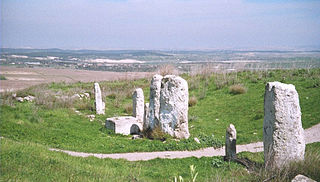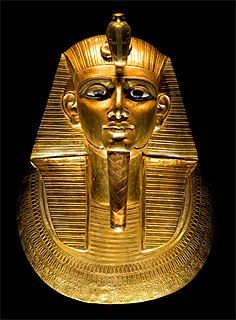This page is based on this
Wikipedia article Text is available under the
CC BY-SA 4.0 license; additional terms may apply.
Images, videos and audio are available under their respective licenses.

Pharaoh is the common title of the monarchs of ancient Egypt from the First Dynasty until the annexation of Egypt by the Roman Empire in 30 BCE, although the actual term "Pharaoh" was not used contemporaneously for a ruler until Merneptah, c. 1200 BCE. In the early dynasty, ancient Egyptian kings used to have up to three titles, the Horus, the Sedge and Bee (nswt-bjtj) name, and the Two Ladies (nbtj) name. The Golden Horus and nomen and prenomen titles were later added.

The 10th century BC started the first day of 1000 BC and ended the last day of 901 BC. This period followed the Late Bronze Age collapse in the Near East, and the century saw the Early Iron Age take hold there. The Greek Dark Ages which had come about in 1200 BC continued. The Neo-Assyrian Empire is established towards the end of the 10th century BC. In the Iron Age in India, the Vedic period is ongoing. In China, the Zhou dynasty is in power. Bronze Age Europe continued with Urnfield culture. Japan was inhabited by an evolving hunter-gatherer society during the Jōmon period.
The 950s BC is a decade which lasted from 959 BC to 950 BC.
Psusennes III was the High Priest of Amun at Thebes at the end of the 21st Dynasty. Little is known of this individual; he is thought by some to be the same person as (King) Psusennes II. His name appears on a document found at the 'mummy cache' DB320 which describes him as a son of the High Priest Pinedjem II. This makes him a possible candidate for Psusennes II because Pinedjem II died in Year 10 of Siamun, who was the immediate predecessor of this Pharaoh.

Gezer, or Tel Gezer (also Tell el-Jezer), also known as Abu Shusheh, is an archaeological site in the foothills of the Judaean Mountains at the border of the Shfela region roughly midway between Jerusalem and Tel Aviv. It is now an Israeli national park. In the Hebrew Bible, Gezer is associated with Joshua and Solomon.

Titkheperure or Tyetkheperre Psusennes II [Greek Ψουσέννης] or Hor-Pasebakhaenniut II [Egyptian ḥr-p3-sb3-ḫˁỉ-<n>-nỉwt], was the last king of the Twenty-first dynasty of Egypt. His royal name means "Image of the transformations of Re" in Egyptian. Psusennes II is often considered the same person as the High-Priest of Amun known as Psusennes III. The Egyptologist Karl Jansen-Winkeln notes that an important graffito from the Temple of Abydos contains the complete titles of a king Tyetkheperre Setepenre Pasebakhaenniut Meryamun "who is simultaneously called the HPA and supreme military commander." This suggests that Psusennes was both king at Tanis and the High Priest in Thebes at the same time, meaning he did not resign his office as High Priest of Amun during his reign. The few contemporary attestations from his reign include the aforementioned graffito in Seti I's Abydos temple, an ostracon from Umm el-Qa'ab, an affiliation at Karnak and his presumed burial – which consists of a gilded coffin with a royal uraeus and a Mummy, found in an antechamber of Psusennes I's tomb at Tanis. He was a High Priest of Amun at Thebes and the son of Pinedjem II and Istemkheb. His daughter Maatkare B was the Great Royal Wife of Osorkon I.

Senakhtenre Ahmose was the seventh king of the Seventeenth dynasty of Egypt during the Second Intermediate Period. Senakhtenre reigned for a short period over the Theban region in Upper Egypt at a time where the Hyksos 15th dynasty ruled Lower Egypt. Senakhtenre died c.1560 or 1558 BC at the latest.

Psusennes I was the third pharaoh of the 21st Dynasty who ruled from Tanis between 1047–1001 BC. Psusennes is the Greek version of his original name Pasibkhanu or Pasebakhaenniut, which means "The Star Appearing in the City" while his throne name, Akheperre Setepenamun, translates as "Great are the Manifestations of Ra, chosen of Amun." He was the son of Pinedjem I and Henuttawy, Ramesses XI's daughter by Tentamun. He married his sister Mutnedjmet.

Aakheperre Setepenre Osorkon the Elder was the fifth king of the 21st Dynasty of Ancient Egypt and was the first Pharaoh of Meshwesh origin. He is also sometimes known as Osochor, following Manetho's Aegyptiaca.
Setepenre is an often-used title of Egyptian kings (pharaohs), meaning "Elect of Re". It was also used as a personal name in at least two instances.
Djedkhonsuefankh was a High Priest of Amun in Thebes believed to have been in office from 1046-1045 BC.
Ramose was an ancient Egyptian prince of the eighteenth dynasty; probably the son of Pharaoh Ahmose I.

Neskhons, once more commonly known as “Nsikhonsou”, was a noble lady of the 21st dynasty of Egypt.
Neterkheperre Meryptah called Pipi II was a High Priest of Ptah during the 21st Dynasty. He was High priest during the reigns of Psusennes I, Amenemope, Osochor and Siamun.
Ashakhet II was a High Priest of Ptah during the 21st Dynasty. He served during the reigns of Siamun and Psusennes II.

The Theban Tomb TT68 is located in Sheikh Abd el-Qurna, part of the Theban Necropolis, on the west bank of the Nile, opposite to Luxor.
Karimala was a Nubian queen. She is known from a relief found at the temple in Semna in Nubia.










